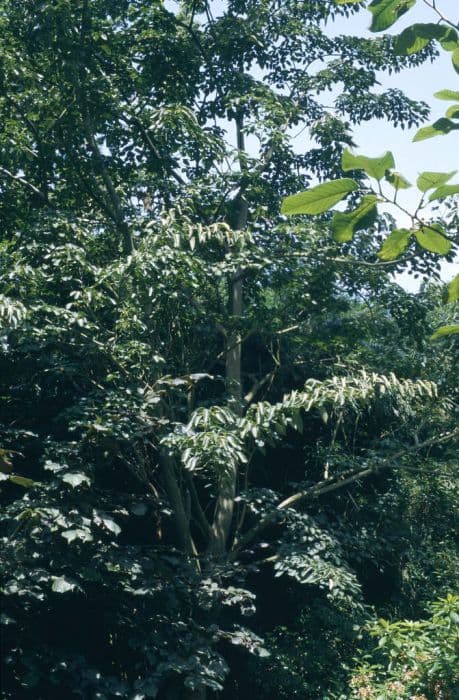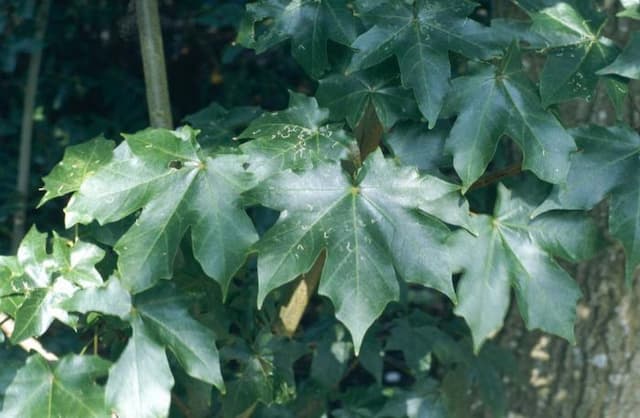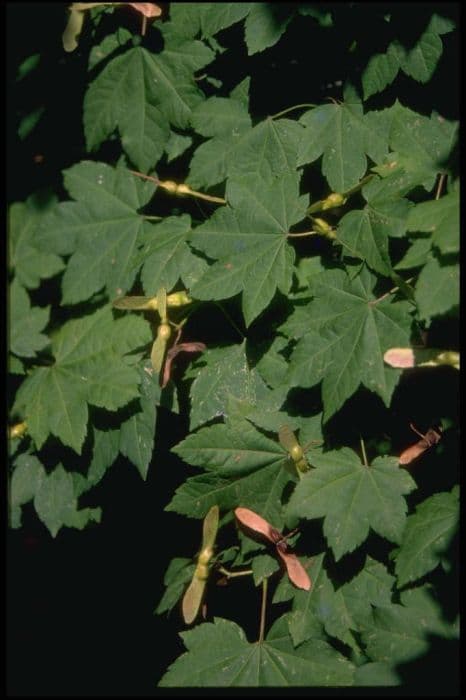Japanese Maple Acer palmatum (D)

ABOUT
The plant known as Japanese maple is cherished for its unique and attractive shape and foliage. This plant typically features a rounded to dome-like canopy with branches that spread outwards in an elegant manner. The leaves are perhaps the most distinctive aspect of the Japanese maple; they are palmate, which means they resemble an open hand with fingers spreading out from the palm. Each leaf generally has five to nine deeply cut lobes, giving them a feathery appearance. The foliage of the Japanese maple comes in a variety of colors that can change with the seasons. The leaves can range from green to red, purple, or orange, depending on the cultivar. These colors can be especially vibrant in the autumn when the leaves often turn a brilliant array of reds and oranges, providing a very striking display. The Japanese maple also has an interesting bark that adds to its visual appeal. The bark can be smooth and may sometimes feature a pattern of striations that vary in color from grey to a more reddish-brown, again depending on the specific type. In addition to its leaves and bark, the Japanese maple also produces small flowers in spring. These flowers are often a subtle red or purple and may be followed by winged seed pods called samaras that hang from the branches and can add extra texture and interest to the plant. Overall, the Japanese maple's aesthetic is one of delicate beauty, with fine leaves and a graceful structure that can add elegance to any garden setting. Its alluring appearance and seasonal color changes make it a favorite among garden enthusiasts and landscapers alike.
About this plant
 Names
NamesFamily
Sapindaceae
Synonyms
Japanese Maple, Smooth Japanese Maple, Palmate Maple
Common names
Acer palmatum var. dissectum, Acer palmatum f. dissectum, Acer palmatum var. linearilobum, Acer palmatum var. amoenum, Acer palmatum var. heptalobum, Acer palmatum var. ornatum, Acer palmatum var. roseomarginatum.
 Toxicity
ToxicityTo humans
The Japanese maple is generally considered non-toxic to humans. There are no significant symptoms of poisoning associated with this plant since it is not known to be poisonous. Therefore, ingestion of the Japanese maple does not typically result in any harmful consequences to people.
To pets
The Japanese maple is also viewed as non-toxic to pets. It is not commonly associated with poisoning in animals such as dogs and cats. Ingesting parts of this plant should not produce any significant toxic symptoms or dangerous health effects in your pets.
 Characteristics
CharacteristicsLife cycle
Perennials
Foliage type
Deciduous
Color of leaves
Varies
Height
15-25 feet (4.5-7.6 meters)
Spread
10-20 feet (3-6 meters)
Plant type
Tree
Hardiness zones
5-9
Native area
Japan Korea China
Benefits
 General Benefits
General Benefits- Aesthetic appeal: Acer palmatum, known as Japanese Maple, has stunning foliage that changes colors with the seasons, offering a beautiful display throughout the year.
- Landscape versatility: These trees can be used in a variety of landscape designs, from traditional to contemporary.
- Shade provision: Japanese Maples create canopy coverage that offers shade in gardens and outdoor spaces.
- Habitat support: The tree provides shelter and food for wildlife, such as birds and insects.
- Compact growth: Smaller cultivars are ideal for containers or limited spaces, making them a good choice for urban gardens.
- Seasonal interest: With their vibrant fall colors, Japanese Maples become a focal point in autumn gardens.
- Cultural significance: Japanese Maples are often associated with peace and serenity, frequently found in Japanese gardens.
 Medical Properties
Medical PropertiesThis plant is not used for medical purposes.
 Air-purifying Qualities
Air-purifying QualitiesThis plant is not specifically known for air purifying qualities.
 Other Uses
Other Uses- Acer palmatum, commonly known as Japanese maple, can be utilized in bonsai cultivation due to its naturally intricate branch structure and aesthetically pleasing leaves, which change color through the seasons.
- The wood of Japanese maple is occasionally used in the creation of small woodworking projects, including fine furniture and ornamental boxes, owing to its beautiful grain patterns.
- Branches and leaves of the Japanese maple are sometimes incorporated into floral arrangements or used as standalone decorative elements due to their distinctive shapes and colors.
- In garden design, Japanese maple can be used as a natural shade canopy for shade-loving plants or as a dramatic focal piece in landscape compositions.
- The fallen leaves of the Japanese maple provide a colorful mulch option in autumn, which can decompose and enrich the soil with nutrients.
- Japanese maple can be planted to help combat soil erosion on slopes or banks due to its dense root system and foliage cover.
- The sap of Japanese maple can be used for syrups or sweeteners, similarly to how sap is harvested from other maple species, although this is not a common practice due to the tree size.
- As a natural art medium, the unique leaf shape and vibrant fall colors of Japanese maple leaves can be pressed and used in botanical prints or craft projects.
- Dried and preserved Japanese maple branches can be used in ornamental indoor displays, adding a touch of nature to interior decor.
- Gardeners often use leaf cuttings from Japanese maple for propagating new plants in a process known as softwood cuttings, a common practice for horticulturists and enthusiasts.
Interesting Facts
 Feng Shui
Feng ShuiThe Japanese Maple is not used in Feng Shui practice.
 Zodiac Sign Compitability
Zodiac Sign CompitabilityThe Japanese Maple is not used in astrology practice.
 Plant Symbolism
Plant Symbolism- Peace – The Japanese Maple, with its gracefully arching branches and serene aesthetic, is often associated with peace and tranquility.
- Beauty – Known for its stunning foliage that changes color with the seasons, the Japanese Maple symbolizes beauty and elegance.
- Endurance – The ability of this plant to withstand harsh conditions and to change with the seasons is seen as a representation of endurance and resilience.
- Balance – With its finely cut leaves and balanced branching, the Japanese Maple is often correlated with harmony and balance in life.
- Grace – The delicate leaves and overall form capture the essence of grace, making it a symbol of refined beauty.
- Great Blessings – In Japan, the Japanese Maple is a beloved tree and is sometimes associated with great blessings and positive energy.
 Water
WaterJapanese Maples, like the Acer palmatum, should be watered deeply once a week during the growing season, especially when they’re young or newly transplanted. To ensure proper hydration, apply around 10 gallons of water for each inch of the tree’s trunk diameter at chest height. During the hot summer months or in drier climates, it may be necessary to water twice weekly. It’s crucial to reduce watering frequency in the fall to encourage hardening off before winter sets in. Proper mulching can help retain soil moisture and decrease the need to water frequently.
 Light
LightJapanese Maples thrive in locations with dappled or afternoon shade, especially in regions with hot summers. They perform well with morning sunlight and protection from the harsh afternoon sun. An ideal spot is one that receives filtered light; full sun may be tolerated in cooler climates but can lead to leaf scorch in hotter areas.
 Temperature
TemperatureThe Japanese Maple fares best in temperatures ranging from 60°F to 80°F but can survive minimum winter temperatures down to -20°F once fully established. The ideal temperature range for these trees is between 70°F and 80°F during their active growth period. They can endure short temperature spikes above these ranges but prolonged exposure can cause stress.
 Pruning
PruningPrune Japanese Maples primarily to maintain their shape and health, removing any dead or crossed branches during late winter or early spring before new growth starts. Thinning the canopy to let light into the interior of the tree promotes healthy growth. Pruning is best kept to a minimum with these trees, and major pruning should occur in mid-summer to minimize sap loss.
 Cleaning
CleaningAs needed
 Soil
SoilJapanese Maple thrives in well-draining soil rich in organic matter with a pH range of 5.5 to 6.5. A mix of loam, peat, and pine bark is suitable for good growth and health.
 Repotting
RepottingJapanese Maple should be repotted every 2-3 years to ensure it is not pot-bound and to refresh the soil, though mature trees can be repotted less frequently.
 Humidity & Misting
Humidity & MistingJapanese Maple prefers moderate humidity levels but can tolerate a range of conditions; avoid extremely dry environments to maintain its health.
 Suitable locations
Suitable locationsIndoor
Give Japanese Maple bright light and protect it from dry heat sources.
Outdoor
Plant in partial shade, protect from harsh winds, and mulch roots.
Hardiness zone
5-9 USDA
 Life cycle
Life cycleAcer palmatum, commonly known as Japanese maple, begins its life cycle as a seed, which after stratification in cold temperatures for about 90-120 days, will germinate in the spring. Following germination, the seedling grows into a juvenile tree, developing a root system and foliage that is characteristic for this species, with its distinctive palmate leaves. As the tree matures, it undergoes secondary growth, thickening its stem and expanding its root system, while continuing to produce new leaves and branches each year. Japanese maples can begin to reproduce when they reach sufficient maturity to flower, which typically occurs after a few years of growth; they produce small reddish-purple flowers that subsequently develop into winged samaras (seed pods). After pollination and seed maturation, these samaras are dispersed by wind, allowing new seeds to spread to suitable locations for germination. The mature Japanese maple has a lifespan that can exceed 100 years, enduring through seasonal changes with leaves that transition through shades of green, red, and gold before being shed in the fall.
 Propogation
PropogationPropogation time
Late summer
The Japanese Maple (Acer palmatum (D)) is most commonly propagated by softwood cuttings taken during late spring or early summer. To do this, select a healthy, young branch and cut a piece about 4 to 6 inches (10 to 15 centimeters) long, making sure there are at least two or three pairs of leaves. Use a sharp knife to make a clean cut just below a node, where the leaf meets the stem. Remove the leaves from the bottom half of the cutting, dip the cut end into a rooting hormone powder, and then insert it into a pot filled with a well-draining potting mix. Keep the soil moist and the environment humid, often by covering the pot with a plastic bag. The cutting should root in several weeks, after which you can transplant it into a larger pot or into the garden.





![Freeman maple [Autumn Blaze]](/_next/image?url=https%3A%2F%2Fplants-admin.emdemapps.com%2Fimages%2Fplants%2F%2Fimages%2F604b575b84d87.png&w=640&q=75)



